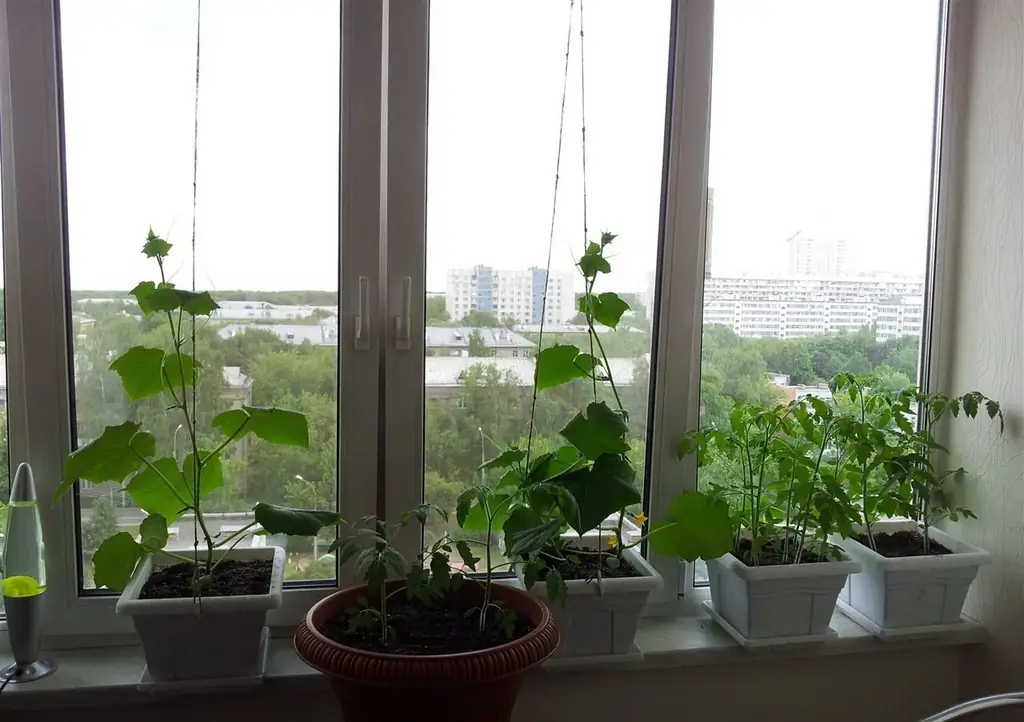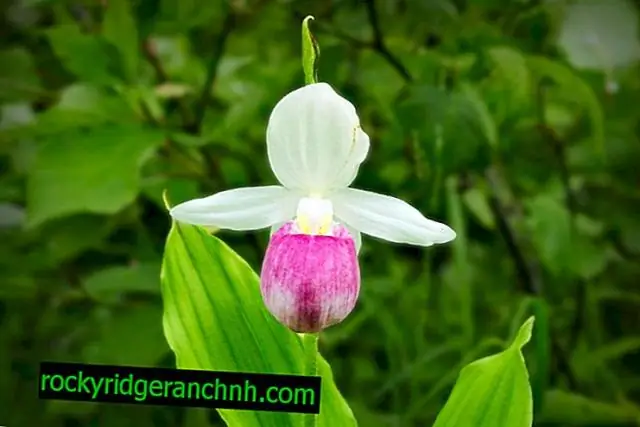
Table of contents:
- How to grow cucumbers on the windowsill in winter?
- What you need to know and which seeds to choose
- Choosing soil, planting seeds
- Cucumber seed germination process
- Seed or seedling planting options
- How to properly care for cucumbers during growth
- Supports and feeding for cucumbers
- Video about growing cucumbers on a windowsill in winter
- Author Bailey Albertson [email protected].
- Public 2023-12-17 12:53.
- Last modified 2025-01-23 12:41.
How to grow cucumbers on the windowsill in winter?

In winter, fresh vegetables can be safely attributed to delicacies: they are not cheap, and it is difficult to find a good quality product. But how you want to feast on cucumbers plucked from a bush, and not pickled! Therefore, more and more Internet users are interested in what is needed to grow cucumbers on a windowsill in winter.
Content
- 1 What you need to know and which seeds to choose
- 2 Choosing the soil, planting seeds
- 3 The process of germinating cucumber seeds
- 4 Options for planting seeds or seedlings
- 5 How to properly care for cucumbers during growth
- 6 Supports and feeding for cucumbers
- 7 Video about growing cucumbers on a windowsill in winter
What you need to know and which seeds to choose
Correctly selected varieties of cucumbers are the key to good growth and a high yield. It should be remembered that in an apartment or house, the conditions for growing vegetables are sharply different from open ground in the summer. Therefore, the seeds must be suitable.
The optimal varieties of cucumbers for growing in winter on the windowsill are called hybrids such as:
- Claudia F1;
- "Marinda F1";
- Bianca;
- "Masha";
- "Moscow greenhouse";
- "Romance";
- "Gribovchanka";
- "Legend".
These varieties are self-pollinating, they are not capricious and you do not have to pollinate them manually during flowering to achieve the ovary. Such hybrids give a high yield of tasty fruits up to 25 cm in size.

The right seed varieties will ensure a good harvest
Also, fans of growing cucumbers at home distinguish the variety "Room Rykov". Although he belongs to bee-pollinated, he feels very good in indoor conditions and is not at all capricious.
- In winter, the growth of cucumbers usually slows down. If the seeds are sown in the first decade of December, the fruits will ripen by the end of February. If you want to get your first crop by the end of March, plant at the very beginning of February.
- Good, properly created conditions for the growth of cucumbers will provide you with a harvest of 30-40 fruits per bush. Pick up ripe vegetables in time to avoid rotting or overripe.
- The cucumber bush does not tolerate cold or excessive heat. Do not hold the container with the plant too close to a window, which may freeze, or near a hot battery.
- The optimal location of the cucumber bush is by the windows facing east or south.
- Cucumber is a light-loving plant. You may need additional lighting as the optimal lighting duration is 6-12 hours.
Choosing soil, planting seeds
Properly prepared soil is the best breeding ground for growing seedlings. You can purchase it in specialized stores, or you can prepare it yourself. In the fall, stock up on a mixture of humus and turf. The optimal proportion is 1: 1 or 1: 3, respectively.
Add to the bucket of the mixture:
- 50 grams of lime;
- 2 glasses of wood ash;
- potash, nitrogen and phosphorus fertilizers - 5 grams each.
Mix the resulting mass thoroughly and place in polyethylene bags. Be sure to check the looseness and softness of the soil.
Also, experts recommend using a substrate of vermicompost and coconut fiber in a ratio of 1: 2.

Before planting in the soil, cucumber seeds need to germinate
The seeds must be germinated first. To do this, they are wrapped in a damp cloth, for example, in gauze, and placed on a saucer, which is placed on a well-lit surface. Additional seed treatment can be carried out. Dip them in a warm, weak solution of potassium permanganate and leave for 3 hours. Floated seeds can be thrown away - they have low germination. Remove those that have sunk to the bottom and leave to drain on a cotton cloth.
When the size of the sprouted roots reaches 0.5-1 cm, plant the seeds in pots in pairs.
Cucumber seed germination process






Seed or seedling planting options
Cucumber seeds can be planted in two ways: directly into a prepared pot, or into cups, followed by picking (transplanting). The second method is more costly and troublesome, but it allows you to weed out unsuccessful and weak shoots before the final planting for quality growth.

Healthy seedlings of cucumber seeds in the soil
- The diameter of the seedling pots should be at least 10 cm. The best option is a capacity of 3 to 4 liters. Pour the soil into the pot, tamping slightly, spread the seeds and add the soil with a layer of 1.5 cm. About 4 cm of space should remain to the top edge, which will need to be filled up after a month. Thus, the most powerful seedlings will break through to the surface.
- When you plant the seeds, cover the pots with plastic wrap until the seeds emerge. The best air temperature for growing cucumbers is 20 degrees.
- After seed germination, be sure to ventilate the room where the cucumber pots are located, providing fresh air. Now you can lower the temperature in the room to 15-16 degrees. At higher temperatures, the sprouts can stretch in length, which will adversely affect both the shape of the bush and the fruit yield.
- If you decide to grow seedlings in cups so that you can then dive them into large pots, then the transplant should be done about 4 weeks after germination. Gently grasp the glass, holding the seedlings between your fingers, and gently shake the soil out into your palm. Without shaking off the soil from the roots of the seedlings, place the clod in a prepared pot filled with the mixture. Cover the remaining space with earth to the level at which the cotyledon leaves are.
How to properly care for cucumbers during growth
Among all vegetables, cucumbers "leave" before anyone else. If you grow cucumbers on the windowsill in pots in winter, then their life will be about 2 months from the moment the first harvest is obtained.
- The growing season of cucumbers is short. The plant begins to bear fruit about 4 weeks after planting. Since, unlike tomatoes and peppers, the cucumber does not propagate by cuttings, the bush must be changed a maximum of 3 months after it began to bear fruit.
- Shake the shrub a little once a day during flowering to ensure better pollination.
- After about 5 full-fledged leaves appear on the bush, the cucumber is pinched. This will give density and splendor to the plant, and will not allow the branches to grow. Thus, you get two short lashes instead of one long one. All ovaries formed up to the pinching point and on it must be removed.
- Cucumbers are very sensitive to moisture. Provide them with regular watering, the ground should always be moist. Drying out of the soil or excessive dryness of the surrounding air will lead to shedding of the ovary from the bush. Spray the plant with a spray bottle twice a day.
- Getting too involved with hydration is also harmful. Overflowing the plant, especially during its initial growth period, increases the risk of diseases such as black leg.
- When growing cucumbers on a windowsill in winter, do not water them too often, since there is not much heat and sun during the cold period. The exception is when the air in the room is too dry.

The soil in the pot with cucumber seedlings should always be moist.
Supports and feeding for cucumbers
Cucumber is a climbing plant, and its lashes can reach considerable lengths, even if you pinned them correctly. Therefore, it is very important to provide him with a good support of a suitable height, from 70 cm to 1 m. You can use a net, trellis, support of any shape, the main thing is strong and stable.
In addition, the support should be light and comfortable, because at least once a day, the potted plant must be rotated 180 degrees around its axis (this also applies to seedlings in cups). Each plant stretches with leaves and stems to the light source, therefore, leaving the cucumber bush in one position for too long, you risk getting an asymmetrical, ugly and curved bush, which will eventually affect the harvest.

Support the cucumber bush
To prolong the life of the bush and get a bountiful harvest, do not forget to feed the cucumbers every 2-3 weeks. This can be done in the following ways:
- Pour fresh vermicompost into the pot once a month;
- pour the solution of the "Growth" product - 1 cap for 2 liters of water;
- a small amount of Agrolife (1 teaspoon) on the topsoil;
- after the buds appear, the plants need to be fed with wood ash (1 glass per 10 liters of water).
It will also be useful to feed from 25 grams of mineral complex fertilizer or 100 grams of garden mixture diluted in 10 liters of water. The consumption of such a solution for 1 plant will be 250-500 grams.
When the plant begins to harvest, be sure to harvest the fruit on time. Overripe should not be allowed: in this way, the bush gives useful juices to aging fruits instead of distributing them among new, ripening and setting ones.
Video about growing cucumbers on a windowsill in winter
We all love fresh vegetables very much, and in winter it is especially important to have a constant source of vitamins on hand. As you can see, growing cucumbers at home in winter on your own is not only possible, but also very simple. You only need to be patient and properly care for the plant so that it will delight you with a generous harvest.
Surely our readers know the secrets of growing cucumbers on the windowsill in winter. Please share them in the comments, as well as ask questions that you might have after reading our article. We wish you a big harvest and comfort in your home!
Recommended:
Growing Cucumbers On A Trellis In The Open Field - Rules + Photos And Videos

Features of growing cucumbers on a trellis in the open field. Construction and installation of trellises, preparation for planting cucumbers, rules for planting in open ground
The Nuances Of Growing Cucumbers Chinese Miracle + Photo

Detailed description of the variety of cucumbers Chinese miracle. Features of planting, growing and care. Disease and pest control. Harvesting and storage. Reviews
Cucumbers Courage F1 - A Description Of The Features Of The Variety And Important Nuances Of Growing + Photo

Cucumber variety Kurazh F1: description of features, main rules of growing and care. What are the advantages of a hybrid?
Dill: Growing From Seeds At Home (on The Windowsill And Balcony), Step By Step Instructions

How to choose a variety of dill for home growing. How to plant and care for: instructions with a photo
Growing Pepper Seedlings At Home: When To Plant According To The Lunar Calendar 2019, On The Windowsill, In The Greenhouse And Not Only With Video

How to prepare everything you need for growing pepper seedlings at home, sow seeds and grow in a suitable way for a gardener
